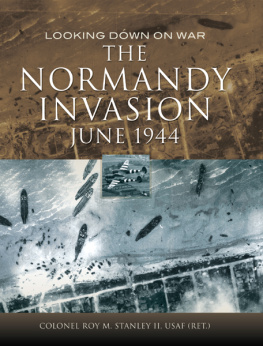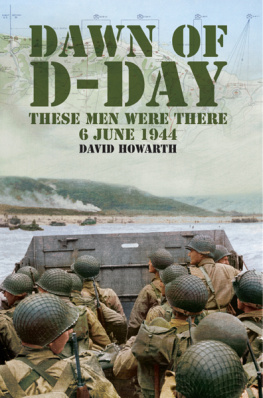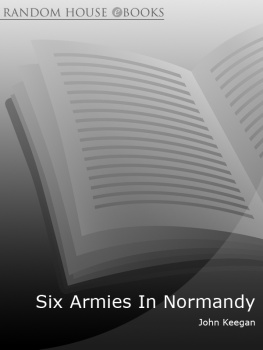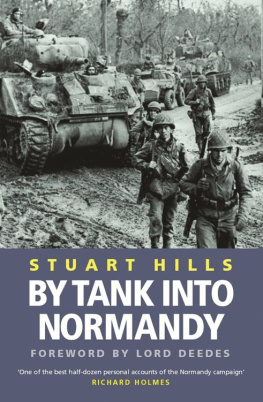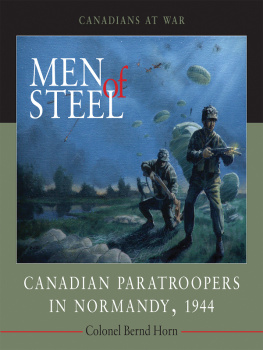Col Roy M. Stanley II - The Normandy Invasion, June 1944: Looking Down on War
Here you can read online Col Roy M. Stanley II - The Normandy Invasion, June 1944: Looking Down on War full text of the book (entire story) in english for free. Download pdf and epub, get meaning, cover and reviews about this ebook. year: 2013, publisher: Pen & Sword Military, genre: Non-fiction. Description of the work, (preface) as well as reviews are available. Best literature library LitArk.com created for fans of good reading and offers a wide selection of genres:
Romance novel
Science fiction
Adventure
Detective
Science
History
Home and family
Prose
Art
Politics
Computer
Non-fiction
Religion
Business
Children
Humor
Choose a favorite category and find really read worthwhile books. Enjoy immersion in the world of imagination, feel the emotions of the characters or learn something new for yourself, make an fascinating discovery.
- Book:The Normandy Invasion, June 1944: Looking Down on War
- Author:
- Publisher:Pen & Sword Military
- Genre:
- Year:2013
- Rating:5 / 5
- Favourites:Add to favourites
- Your mark:
- 100
- 1
- 2
- 3
- 4
- 5
The Normandy Invasion, June 1944: Looking Down on War: summary, description and annotation
We offer to read an annotation, description, summary or preface (depends on what the author of the book "The Normandy Invasion, June 1944: Looking Down on War" wrote himself). If you haven't found the necessary information about the book — write in the comments, we will try to find it.
The Normandy Invasion, June 1944: Looking Down on War — read online for free the complete book (whole text) full work
Below is the text of the book, divided by pages. System saving the place of the last page read, allows you to conveniently read the book "The Normandy Invasion, June 1944: Looking Down on War" online for free, without having to search again every time where you left off. Put a bookmark, and you can go to the page where you finished reading at any time.
Font size:
Interval:
Bookmark:
DEDICATION
To Jack, Phil, Marv, Gil, Peter, Roy C., John, George, and Pete. Top notch USAF Intelligence professionals, old comrades-in-arms and treasured friends who achieved amazing things four and a half decades ago. In our day no one in the world could read out a major photoreconnaissance mission faster or better. Some are gone but none forgotten.
Other Books by the Author
World War II Photo Intelligence
Prelude To Pearl Harbor
To Fool A Glass Eye
Asia From Above
V-Weapons Hunt
Axis Warships
First published in Great Britain in 2012 by
PEN & SWORD MILITARY
an imprint of
Pen & Sword Books Ltd,
47 Church Street,
Barnsley, South Yorkshire
S70 2AS
Copyright Colonel Roy M. Stanley II 2012
ISBN 978 1 78159 056 0
EPUB ISBN: 978 1 47382 232 0
PRC ISBN: 978 1 47382 184 2
The right of Colonel Roy M. Stanley II to be identified as Author of this work has been
asserted by him in accordance with the Copyright, designs and Patents Act 1988.
A CIP record for this book is
available from the British Library.
All rights reserved. No part of this book may be reproduced or transmitted in any
form or by any means, electronic or mechanical including photocopying, recording
or by any information storage and retrieval system, without permission from
the Publisher in writing.
Typeset by CHIC GRAPHICS
Printed and bound by CPI Group (UK) Ltd, Croydon, CR0 4YY
Pen & Sword Books Ltd incorporates the Imprints of
Pen & Sword Aviation, Pen & Sword Family History, Pen & Sword Maritime, Pen &
Sword Military, Pen & Sword Discovery, Wharncliffe Local History, Wharncliffe True
Crime, Wharncliffe Transport, Pen & Sword Select, Pen & Sword Military Classics,
Leo Cooper, The Praetorian Press, Remember When, Seaforth Publishing
and Frontline Publishing.
For a complete list of Pen & Sword titles please contact
PEN & SWORD BOOKS LIMITED
47 Church Street, Barnsley, South Yorkshire, S70 2AS, England
E-mail:
Website: www.pen-and-sword.co.uk
CONTENTS
ACKNOWLEDGEMENTS
A nod of appreciation to Pen & Swords Brigadier Henry Wilson for seeing merit in the book, and to Matt Jones and Sylvia Menzies-Earl for putting up with my incessant changes while shepherding my seventh into print. A big tip of the hat to Susan Strange, independent researcher at the US National Archives Cartographic Branch, who has an exceptional talent for locating photos and documents. Gratitude to Chris Halsall and the folks at the Medmenham Archives for finding imagery I needed to fill in gaps. Thanks to Caroline Walsh and the BBC Interview Team for trading copies of images and ideas on the invasion. As always, a special thanks to my wife, Mary Ellen for putting up with photos strewn about the house, my long hours in research and writing, and demands for her excellent editing skills.
FOREWORD
If youve bought one of my earlier books (consider that a patriotic duty) you know my forte is photo interpretation (PI) of World War II aerial imagery, which I consider a major and underused primary source for understanding military history. My judgments and comments are based less on secondary sources than on imagery in my hands and my experience as a PI and Combat Intelligence Analyst. In this case Im looking at the Normandy Invasion just as I would have any imagery-based study assigned when I was on active duty.
Preparing material for what I intended to be my seventh book I realized I had enough material for a separate book on the Normandy Invasion and changed direction.
You may ask what could I publish that would be new and different? The reader has likely seen some aerial views of the Normandy Invasion, but have you really SEEN them? Its been almost seven decades since the Normandy landings, how can I show you pictures of things youve never seen before?
I can because:
Most historians dont have the skills necessary to find and understand what youll see on these pages - particularly in my enlargements.
Many of the recon photos in this book were collected when no one could be sure the Normandy Invasion would succeed, but by dark, certainly by mid-day on 7 June, troops were pushing inland expanding the beachheads and failure was no longer a possibility. On 6 and 7 June 1944 there was no incentive to expend scarce PI resources searching images of where the troops had been. PIs were searching farther inland to spot things the troops were going to encounter - and elsewhere to find the threatening V-1 launch locations springing up all over coastal France. So many of the images Ive found were never selected and published, some possibly never looked at.
PIs in 1944 didnt have the ability to easily enlarge and scan images like we can today using computers. Photographic enlargement was slow and inflexible, not good for trolling through a mission, thus many of the images in my enlargements remained unseen. I didnt have computer enlargement capacity when I first found these photos so some of the images included here surprised me when I discovered them during research for this book using computer enlargement.
I dont pretend to know all the details of every event, piece of equipment or subject, nor do I think Ive seen all of the available imagery, but I will interpret the imagery Ive found for you. I think youll find my USAF photo interpretation training and experience let me see a LOT more than most people writing conventional textual history. Most books on World War II use readily available and easily understood ground photos. Occasionally a book will show an aerial to prove a point or make the narrative more interestingbut without the benefit of photo interpretation. My books use imagery selected to tell the story. For me, text is an adjunct used to identify something, put it into context, or move the story along. In this book you will see well-known events from a different perspective. Dont think of this as a PowerPoint presentation or lecture seriesthink of it as the two of us sitting together in my library going through a stack of WW II prints, and Im telling you what the photos say to me.
If youve got any of my earlier books you know how I discovered this imagery. As holders of DoD aerial film archives the unit I was in was under pressure to reduce cost of holdings, some of which had been dormant since the 1940s. Loath to destroy unknown material, I began a screening to see what we had. Missions I found from 6 or 7 June 1944 (and other dates I knew were significant) were sent to the U.S. National Archives to keep them safe. Ive been told there was originally more aerial film but some was dumped in the ocean to save cost of shipping it back to America after the war. Ive also been told by old timers, but couldnt confirm, that much of low altitude, oblique coverage was destroyed by the Cartography community (who were the first post-war recipients of the original roll film negatives) because it had no value for mapping.
I found only selected cut negative copies of British imagery. We assumed (hoped) all the original British-source material was in England.
Clearly little of the designated material still had any Intelligence value in the 1980s but I began to find images I KNEW were historic and created over one hundred 30 x 40 display boards for our halls to create interest in the material. People cleared to enter our secure precincts were soon commenting favorably on photos of famous bombing raids, the building of the Pentagon, Pearl Harbor before 7 December 1941 and D-Day.
When I collected these photos I had no thought of someday writing a book on the Normandy Invasion. I just knew the photos were important and interesting. Sorting what I had, assembling chapters for this book three decades later, I wish Id looked harder and kept more and used entire missions to plot locations of specific photos. I made heavy use of Google Earth maps to match fields and roads but you must bear with me when I cant always tell you a precise location. It also explains why some landing beaches have more coverage than others. It isnt because I consider any assault site lesser for any reason. Its simply because I didnt find, or didnt recognize, more material covering them.
Next pageFont size:
Interval:
Bookmark:
Similar books «The Normandy Invasion, June 1944: Looking Down on War»
Look at similar books to The Normandy Invasion, June 1944: Looking Down on War. We have selected literature similar in name and meaning in the hope of providing readers with more options to find new, interesting, not yet read works.
Discussion, reviews of the book The Normandy Invasion, June 1944: Looking Down on War and just readers' own opinions. Leave your comments, write what you think about the work, its meaning or the main characters. Specify what exactly you liked and what you didn't like, and why you think so.

